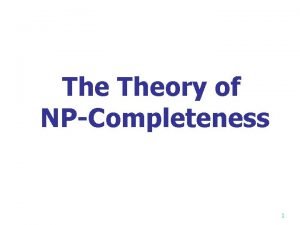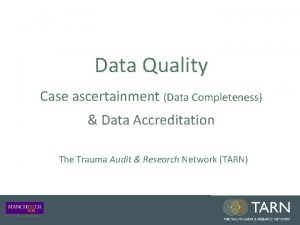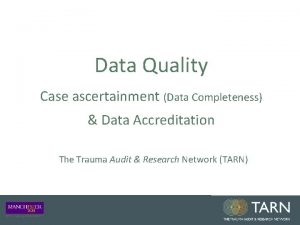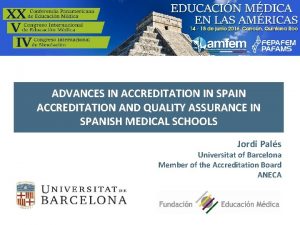Data Quality Case ascertainment Data Completeness Data Accreditation












- Slides: 12

Data Quality Case ascertainment (Data Completeness) & Data Accreditation The Trauma Audit & Research Network (TARN)

Case ascertainment % (quantity) Measure of Expected v Submitted number of cases per Hospital q Expected no. of cases derived from latest HES data q HES: Hospital Episode Statistics (UK Government database) q HES data: ICD 10 codes assigned by Trusts’ Clinical coding teams q TARN inclusion criteria applied: expected no. of cases derived q Expected no. of cases (denominator) compared to no. submitted cases per annum (numerator) q Case ascertainment % calculated for each hospital & Trust

Case ascertainment % (quantity) Measure of Expected v Submitted number of cases per Hospital q % shown on Website, Clinical Reports & Dashboards q Updated every 4 months: End of: March, July & November q Quarterly for Dashboards q Shown by default as 15% range, based on expected variation between HES & TARN q Shown as exact figure, once denominator has been validated (more later) q Target= 80%+: Used to validate published results

Case ascertainment RANGE calculation Expected submissions: DENOMINATOR 100 Submissions: NUMERATOR 70 Case Ascertainment range 70 -82%

Case ascertainment validation exercise q HES v TARN comparison exercise produced each year q Updated when latest HES data is received: November each year q Comparison based on matching NHS numbers in each dataset q 3 months’ pre-selected data used as a representative sample: § July, October and February.

Case ascertainment validation exercise § Green cases: In both TARN & HES datasets: complete § Black cases: In HES dataset only: incomplete § Hospitals to review only the missing ‘black’ cases

Improving case ascertainment in 2 ways 1. Feedback list of ineligible cases to TARN q Cases removed: Denominator reduced 2. Identify missing groups of patients q Include going forward: Numerator increased q Case ascertainment then shown as exact (validated) figure at next update q Validation exercise under Audit tab on TARN website: Currently disabled q Notification via website/newsletter when exercise re-enabled following receipt of latest HES data: Coming soon

Results from previous years REDUCTING DENOMINATOR: Common reasons for removal of cases § Rehabilitation only admissions § Old injuries § Incorrect ICD 10 coding § Non-traumatic injuries INCREASING NUMERATOR: Commonly missed patient groups § Non isolated 65+ Hip fractures § Elderly SDH/SAH admitted to medical wards § Spinal fractures § LOS of exactly 3 day

Data Accreditation % Measure of frequency of CORE data field completion CURRENT ACCREDITATION FIELDS Glasgow Coma Score or Intubation/ventilation (Recorded Pre hospital, ED or first GCS – All cases) Incident or 999 Date/time Arrival time Transfer reason, previous/next hospital, request date CT time Operation time, grade, speciality of surgeon, grade of anaesthetist ED doctors: time, grade & speciality Injury detail – proportion of NFS codes *Pre-existing conditions **Pupil reactivity for patients with AIS 3+ (Serious) head injuries (Recorded in any location – including 1 st hospital) * ** Latest Probability of Survival (Ps)17 model ‘Other’ and ‘Not Known’ detrimental to Data Accreditation Future Probability of Survival model

Data Accreditation shown in Clinical report Overall target 95%+: Used to validate published results

Data Accreditation & Case ascertainment shown on Website & Dashboards

Data Quality online report available on TARN • • Case ascertainment & Accreditation % now shown on report NFS injuries that may affect ISS are now shown • • • Missing fields highlighted in red Scores shown are % Ignore Green fields: not expected or complete






















